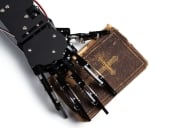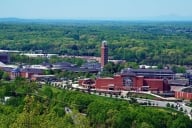You have /5 articles left.
Sign up for a free account or log in.
Don’t try reaching a Wyoming Catholic College student by cell. Students can't have cell phones on campus -- a donated cattle ranch in western Wyoming’s Wind River Mountain Range -- or in the surrounding towns.
Nor can students have television sets, and while there are four computer stations with Internet access in the student lounge, there aren’t any Internet connections in the (single-sex) residence halls. (“Inter-visitation” is punishable by almost certain expulsion, while alcohol consumption is punishable by expulsion, too, says Wyoming Catholic's president, the Rev. Robert W. Cook).
Faculty members at the brand-new college would be expected to ensure that any research paper they assign could be completed within the confines of the college's library and, anyway, Father Cook says, more than 90 percent of the papers that students will ever write at Wyoming Catholic are “not research papers but thinking papers. To quickly get them to do research papers is to ask them not to think. We’re intent on trying to get these youngsters to engage in critical thinking.”
“We say to them, ‘Look, God gave you the greatest computer ever created: your brain.’ ”
The distractions of ever-present technology and the wasted time spent chattering or surfing online are the main reasons for the college’s ban, Father Cook says. The 35 students who make up Wyoming Catholic’s first class this fall are expected instead to spend their time outdoors (students start their academic careers with a three-week mandatory backpacking trip), and focusing on the college’s fixed “great and the good books curriculum." In addition to the classics -- Aristotle, Aquinas and Archimedes -- the curriculum includes a required year of horsemanship.
The faculty members entrusted to carry out that curriculum are all contractually prohibited from publicly rejecting the official teachings of the Roman Catholic church, and all Catholic faculty annually make a profession of faith and take an oath of fidelity -- highly unusual requirements for non-theology faculty at Catholic colleges.
The students, coming from 23 different states, “are convinced that Wyoming Catholic College is an authentically Catholic college, and that is not easy to find these days,” Father Cook says in explanation of the brand-new college’s national appeal. “Perhaps there are just a handful, 20 to 25, that would meet rigorous standards of being truly Catholic.”
The Millennial Catholic Colleges
Wyoming Catholic is the newest – and arguably the most conservative -- outgrowth of a spurt of conservative Catholic colleges established in recent years. These institutions have quickly established themselves, in some cases implicitly and in many cases explicitly, in opposition to what their leaders see as the secularization of many of the nation's more than 200 Catholic colleges. So it’s not surprising that the long-time players in Catholic higher education – the players that these colleges are positioning themselves against – welcome the new colleges to the flock with some reservations.
“When you start talking about, ‘This is an authentic college,’ that suggests that other folks aren’t authentic, and that’s unfortunate,” says the Rev. Charles L. Currie, president of the Association of Jesuit Colleges and Universities. “I wish them well; I just don’t think they should be prescriptive of how to be Catholic today.”
Among the new Catholic colleges:
- John Paul the Great Catholic University, which opened in 2006 as a specialized institution focused on business, media and technology. Catholic universities, the institution says on its Web site (in reference to a speech by former Pope John Paul II), “exist for one reason only: to proclaim the Gospel.”
- The University of Sacramento, founded by a conservative congregation, the Legionaries of Christ, after a nationwide market study. The university, which began offering graduate coursework in January 2005 and now has 90 students, plans to accept its first undergraduate class to a campus in the Sierra Nevada foothills in 2012. The goal is to have 7,000 total students enrolled within 25 years, according to the president, the Rev. Robert Presutti.
- Ave Maria University in Florida, opened in 2003 by Domino’s Pizza mogul Tom Monaghan, whose law school by the same name is moving from Michigan to Florida amid broad concerns about academic freedom.
- Southern Catholic College, which, located on a lakeside campus just north of Atlanta, became the first Catholic college in Georgia after starting classes in fall 2005. Echoing Father Cook of Wyoming Catholic, also the first Catholic college in its state, Southern Catholic’s president, Jeremiah J. Ashcroft, says the 191 students perceive the place as “a truly Catholic college. When I was at mass today, we probably had anywhere between 90 and 110 students [attendance is not required], which indicates what their priorities are." Trustees for the college — who have explicitly embraced a 1990 Vatican document, Ex corde Ecclesiae, that’s associated with efforts to make Catholic colleges more Catholic — include the vicar general of the archdiocese of Atlanta and the president of Minnesota’s St. Thomas University.
The newest wave of conservative colleges mirrors a similar wave in the 1970s, when institutions including Christendom College in Virginia, Thomas Aquinas College in California and Thomas More College of Liberal Arts in New Hampshire were founded, says Patrick Reilly, president of the Cardinal Newman Society, devoted to strengthening the Catholic identities of Catholic colleges.
“These two waves of new colleges are very much a reaction to the secularization of Catholic colleges in the United states,” says Reilly. “These new colleges, what’s very distinct about them, is it’s just not this perceived need for more colleges for more students. It’s a reaction to a perceived failing at the other Catholic colleges that do exist.”
“The common conservative perception out there is that Catholic colleges and universities are all secular, [that] they just have gone to hell,” says Lester F. Goodchild, who is converting his dissertation on Catholic colleges into a book while on sabbatical from his position as director of the higher education program and professor of education at California’s Santa Clara University. Goodchild describes the history of Catholic higher education instead as marked by vacillation between periods of “re-Catholicization” and modernization, with the tensions exacerbated by Vatican efforts to enhance the Catholic identities of Catholic colleges through Ex corde.
“One of the things about higher education is that students have freedom,” Goodchild says. The “real bugaboo,” he says, concerns those “folks who don’t understand what higher education is generally: They don’t understand this thing ‘freedom,’ they don’t understand how this has vacillated over time, and they have no concept,” he adds, of ways in which most Catholic universities manifest their Catholic characters while respecting student and faculty freedoms.
Student and Faculty Freedoms
The new colleges largely define themselves by their commitments to the Magisterium, the church's authority on doctrinal teachings. John Paul the Great University, for instance, explicitly stipulates that it “will intentionally seek to avoid causing controversy and confusion among its students in matters of faith. JP Catholic [as the university refers to itself on its Web site] seeks to shape and form solid Catholic leaders and innovators poised to put into action the teachings of Jesus Christ, and not to become agitators for change on matters of doctrine."
While the university also officially states that “all teaching faculty will commit to harmony with Catholic church teachings” and that those who knowingly and publicly contradict the church “compromise their relationship with JP Catholic," it also explicitly affirms its commitment to having a variety of faiths represented among its students, faculty and staff -- and an atmosphere of mutual respect.
When asked how Wyoming Catholic faculty would handle a hot-button issue that the church has taken a position regarding -- abortion, evolution or homosexuality for instance -- Father Cook says that any class discussion would be driven and informed by the church's position. “For example, we wouldn’t likely end up telling the students that evolution is purely a matter of random chance, not guided by God.” (Five of Wyoming Catholic's six faculty are Catholic, and the plan is to hire a second non-Catholic faculty member next year, Father Cook says. While all 35 of the current students are Catholic, he expects that non-Catholics will enroll as the college expands to its target 400-student enrollment).
At Southern Catholic, where, unlike at Wyoming, faculty are not required to make a profession of faith or take an oath of fidelity, would-be professors are informed during the hiring process of the expectation that they respect the Magisterium. Ashcroft says that faculty would be encouraged to allow classroom discussion on all sides of a cultural debate but, "What we do expect is that the church's teaching is pointed out, so that students are aware of where the church stands on these issues."
“Faculty do feel that there’s academic freedom here, but academic freedom means that you have a responsibility, and that responsibility is to teach the truth as best you know it,” Ashcroft says.
“Many of these schools are in effect reactionary in a way that they would define positively,” says Richard A. Yanikoski, president and CEO of the Association of Catholic Colleges and Universities.
“They’re reactionary in a sense that they assert that there has been a drift of some kind in the broad cross-section, not all, but the broad cross-section of existing Catholic universities as they have modernized and become more ecumenical. These schools hope to provide an alternative for that,” Yanikoski says. “There are students and families that have a strong desire for this kind of insulated, overtly Catholic, small and traditional campus.”
With the exception of the University of Sacramento, these institutions are also distinguished by the fact that, “Most of them, at their core, have a very strong lay presence, often an overwhelming lay presence,” Yanikoski says. Ave Maria and Southern Catholic, for instance, began as the mere brainchildren of entrepreneurial businessmen.
Creating a Subculture
“The phrase Catholic identity is relatively new in the lexicon of higher education,” explains Yanikoski. “Prior to [about 30 years ago], virtually all Catholic colleges were founded either by a religious order or the diocese itself.” With priests and nuns “in religious attire all over the campus…no one ever discussed Catholic identity. It was just so obviously Catholic that identity wasn’t part of the discussion. It was a given.”
Meanwhile, without those visible signs of Catholicism that earlier generations took for granted, survey data suggest that between 10 and 20 percent of under-40 Catholics self-identify as what William Portier, a University of Dayton professor of religious studies, describes as “evangelical.” These “evangelical Catholics, Portier says, choose to be Catholic through the embrace of traditional markers, like the Pope and the Eucharist. “There’s no more Catholic subculture to create Catholic identity and so people create it for themselves. They are choosing to be Catholics in the way that they think is right.”
“It doesn’t surprise me at all that there’s a market” for colleges that define themselves by their strong Catholic identities, Portier says. “But they’re never going to be the majority of schools.”
“The richness of American higher education is diversity, and I think that’s true of Catholic colleges as well,” says Ashcroft, Southern Catholic College’s president. “So I think that what you’re seeing is a demand by many young Catholics for what they consider to be a strong spiritual element and an environment that is committed to the teachings of the church. But I’m not saying that the way we’re doing it is the only way.”








